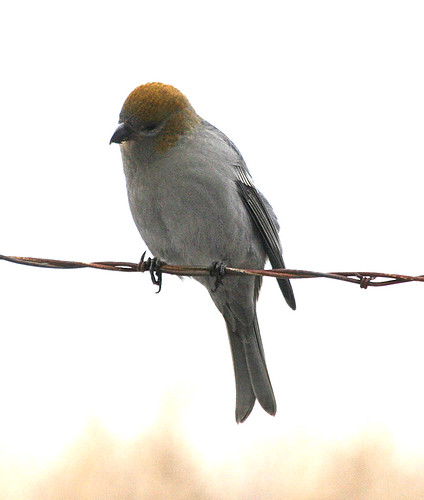tags: Pine Grosbeak, Pinicola enucleator, birds, mystery bird, bird ID quiz
[Mystery bird] Pine Grosbeak, Pinicola enucleator, photographed near Molson, Okanogan County, Washington State. [I will identify this bird for you tomorrow]
Image: Marv Breece, 25 November 2008 [larger view].
Canon EOS 350D 1/500s f/6.3 at 300.0mm iso400.
Please name at least one field mark that supports your identification.
Rick Wright, Managing Director of WINGS Birding Tours Worldwide, writes:
Pride and the fall: until I saw this picture, I would have laughed anyone down the stairs who'd claimed to see a Pine Grosbeak perched on barbed wire. Live and learn!
This is another one of those birds that is what-else-could-it-possibly-be obvious if you know it and just plain puzzling if you don't. Let's assume that this is our first encounter with this species and start at the rear. The tail is medium-long, with an obvious notch; the individual rectrices are narrow and rather acutely pointed, helping us age the bird as in its first winter even before we know its species; that may seem hopelessly academic, but at least it rules out a bright adult anything.
The wing is contrastingly, but not strikingly, dark. I can't see the primary extension, but I can see that the wingtip extends barely beyond the base of the tail, making this a short-winged bird. The underparts are an undistinguished dove-gray, but the head is an unusual, indeed unique, shade of brownish yellow -- "russet," as the field guide descriptions style it.
We can clinch the identification by looking closely at that dark, undersized bill. The culmen is drastically curved, a diagnostic feature of Pine Grosbeak.
My first Pine Grosbeak looked very much like this, and I recall still looking at it perched atop a spruce in Colorado and asking myself out loud "what on earth is that?" Thanks to the historical bias towards male birds in the field guides, female and young male Pine Grosbeaks remain poorly delineated in the average birder's stock of mental images. Distinctive (and beautiful) as they are, non-red birds of this species can take us aback when we first see them -- especially if the encounter involves not a rowan tree or a spruce top, but a wire fence.
- Log in to post comments


I believe that's an adult female Pine Grosbeak. The beak put me in the right family, and from there it was a quick scan for a bird with that unmarked chest and that interesting mustard-colored crown.
It was surprising to me, as someone who's been at least a casual birdwatcher for many decades, to see a North American bird as distinctively marked as this, and initially have no clue at all what it was. I needed to consult my fieldguide to find it. Which I think, in retrospect, is a result of the fact that I've never actively birded in this bird's geographic range, so in all my time paging through the field guide, I've always skipped past the Pine Grosbeak after a glance at the range map (and maybe a glance at the male, which I think I would have recognized pretty readily).
So: a reminder to me that is still a lot of terra icognita around the edges of my perceptual map, still a lot of area to explore. Thanks!
The ID is on the Flicker page.
We have a lot of these guys in our neck of the woods--Dark eye line, mustard head color,and over all gray color.
The first thing that caught my attention is the beak, that sharp hook at the end is fairly unique. The deeply notched tail, plain grey breast and mustard-colored head are diagnostic: female Pine Grosbeak.
As John C. above, I have never seen this species, and would have been clueless had I come across one.
"The ID is on the Flicker page." I'm sorry, I don't know what this means. Could you enlighten me please?
Heh. I am SO glad I came to read these comments. This is the first time I've seen a North American bird posted here and thought, "Wow! I have NO idea what that could be." It's nice to know I'm not the only one. :D
Rick meant Flickr. I guess our hostess forgot to do whatever she does to keep us from being able to see the Flickr page where this was originally posted, which mentioned the species. She seems to have fixed it, though—clicking on the picture doesn't take me anywhere, and clicking on "larger view" takes me to a page with no text (and the same view).
I knew this one too, because we do have them around here in the high mountains, so I've studied them in field guides. I've never gotten a good enough look to see the colors, though, so I enjoyed this picture.